 W
WThe Arakan Campaign of 1942–43 was the first tentative Allied attack into Burma, following the Japanese conquest of Burma earlier in 1942, during the Second World War. The British Army and British Indian Army were not ready for offensive actions in the difficult terrain they encountered, nor had the civil government, industry and transport infrastructure of Eastern India been organised to support the Army on the frontier with Burma. Japanese defenders occupying well-prepared positions repeatedly repulsed the British and Indian forces, who were then forced to retreat when the Japanese received reinforcements and counter-attacked.
 W
WThe Battle of Pakokku and Irrawaddy River operations were a series of battles fought between the British Indian Army and the Imperial Japanese Army and allied forces over the successful Allied Burma Campaign on the China Burma India Theater during World War II. The battles and operations were instrumental in facilitating the eventual capture of Rangoon in summer 1945.
 W
WOperation Battleaxe was a British Army offensive during the Second World War to raise the Siege of Tobruk and re-capture eastern Cyrenaica from German and Italian forces. It was the first time during the war that a significant German force fought on the defensive. The British lost over half of their tanks on the first day and only one of three attacks succeeded.
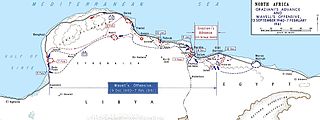 W
WThe rapid British advance during Operation Compass forced the Italian 10th Army to evacuate Cyrenaica, the eastern province of Libya. In late January, the British learned that the Italians were retreating along the Litoranea Balbo from Benghazi. The 7th Armoured Division was dispatched to intercept the remnants of the 10th Army by moving through the desert, south of the Jebel Akhdar via Msus and Antelat as the 6th Australian Division pursued the Italians along the coast road, north of the jebel. The terrain was hard going for the British tanks and Combeforce, a flying column of wheeled vehicles, was sent ahead across the chord of the jebel.
 W
WThe Battle of Bir Hakeim took place at Bir Hakeim, an oasis in the Libyan desert south and west of Tobruk, during the Battle of Gazala. The 1st Free French Brigade defended the position from 26 May – 11 June against much larger Axis forces of Panzerarmee Afrika/Armata Corazzata Africa. The Panzerarmee captured Tobruk ten days later but the delay imposed on the Axis offensive by the defence of the fortress influenced the cancellation of Operation Herkules, a plan for an Axis invasion of Malta. Rommel continued to advance and invaded Egypt, slowed by British delaying actions until the First Battle of El Alamein in July, where the Axis advance was stopped. Both sides used the battle for propaganda, Winston Churchill renamed the Free French as the Fighting French and Hitler called the French the second best fighters after the Germans.
 W
WThe Battle of Christmas Island was a small engagement which began on 31 March 1942, during World War II. Assisted by a mutiny by soldiers of the British Indian Army against their British officers, Imperial Japanese Army troops were able to occupy Christmas Island without any land-based resistance. The United States Navy submarine Seawolf caused severe damage to the Imperial Japanese Navy cruiser Naka during the landings.
 W
WOperation Compass was the first large British military operation of the Western Desert Campaign (1940–1943) during the Second World War. British, Indian, Commonwealth and Allied forces attacked Italian forces of the 10th Army in western Egypt and Cyrenaica, the eastern province of Libya, from December 1940 to February 1941.
 W
WOperation Creek was a military operation undertaken by the Special Operations Executive in World War Two on 9 March 1943. It involved a covert attack by members of the Calcutta Light Horse and the Calcutta Scottish against a Nazi German merchant ship, the Ehrenfels, which had been transmitting information to U-boats from Mormugao Harbour in neutral Portugal's territory of Goa.
 W
WOperation Crusader was a military operation of the Western Desert Campaign during World War II by the British Eighth Army against the Axis forces in North Africa commanded by Generalleutnant Erwin Rommel. The operation was intended to bypass Axis defences on the Egyptian–Libyan frontier, to defeat the Axis armoured forces and to relieve the 1941 Siege of Tobruk.
 W
WThe Battle of Damascus was the final action of the Allied advance on Damascus in Syria during the Syria–Lebanon Campaign in World War II. The initial advance was undertaken by Indian troops who were tasked with capturing Mezzeh while Free French forces were to capture Qadam. While the Free French were held up, the Indian troops were able to capture Mezzeh and then became cut off following a Vichy French counterattack. British and Australian reinforcements were brought up and throughout 19–20 June, the Indian troops holding Mezzeh continued to hold out despite running low of ammunition and rations. Late on 20 June, Australian troops attempted to relieve them and entered the town, arriving to find that the town was deserted, as the remaining Indian troops had been captured by the Vichy French and removed from the town earlier in the day. The following day, the Free French, supported by British and Australian troops, captured Qadim and throughout 21 June further actions were fought around the Quneitra road and the Barada Gorge. By mid-morning on 21 June the Vichy French garrison in Damascus surrendered to the Allied forces.
 W
WThe Battle of Deir ez-Zor was part of the Allied invasion of Syria during the Syria-Lebanon campaign in World War II.
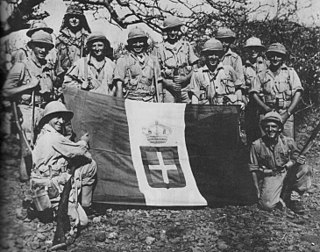 W
WThe East African campaign was fought in East Africa during the Second World War by Allies of World War II, mainly from the British Empire, against Italy and its colony of Italian East Africa, between June 1940 and November 1941. The British Middle East Command with troops from the United Kingdom, South Africa, British India, Uganda Protectorate, Kenya, Somaliland, West Africa, Northern and Southern Rhodesia, Sudan and Nyasaland participated in the campaign. These were joined by the Allied Force Publique of Belgian Congo, Imperial Ethiopian Arbegnoch and a small unit of Free French.
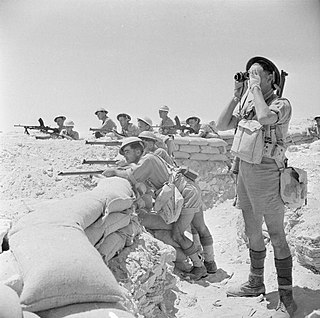 W
WThe First Battle of El Alamein was a battle of the Western Desert Campaign of the Second World War, fought in Egypt between Axis forces of the Panzer Army Africa and Allied forces of the Eighth Army.
 W
WThe Second Battle of El Alamein was a battle of the Second World War that took place near the Egyptian railway halt of El Alamein. The First Battle of El Alamein and the Battle of Alam el Halfa had prevented the Axis from advancing further into Egypt.
 W
WThe Battle of Garfagnana, known to the Germans as Operation Winter Storm and nicknamed the "Christmas Offensive", was a successful Axis offensive against American forces on the western sector of the Gothic Line during World War II. It took place in December 1944 in the north Tuscan Apennines, near Massa and Lucca.
 W
WThe Battle of Gazala was fought during the Western Desert Campaign of the Second World War, west of the port of Tobruk in Libya, from 26 May to 21 June 1942. Axis troops of the Panzerarmee Afrika consisting of German and Italian units fought the British Eighth Army composed mainly of British Commonwealth, Indian and Free French troops.
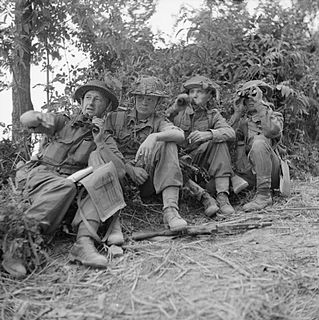 W
WThe Battle of Gemmano took place during World War II, between the dates of September 4th, and September 15th of 1944. The battle occurred in the area of the Gothic Line, near the Apennine Mountains in northern Italy, which would soon turn out to be the last line of defense for the Axis Powers in Italy. The village of Gemmano was eventually captured on September 9th, 1944 by the invading Eighth Army, but two more subsequent attacks were needed to secure the area surrounding the village of Gemmano. Fighting was so fierce, similar to that of the famous battle of Monte Cassino, that the battle was sometimes referred to as, “ The Cassino of the Adriatic”.
 W
WThe Battle of Imphal took place in the region around the city of Imphal, the capital of the state of Manipur in northeast India from March until July 1944. Japanese armies attempted to destroy the Allied forces at Imphal and invade India, but were driven back into Burma with heavy losses. Together with the simultaneous Battle of Kohima on the road by which the encircled Allied forces at Imphal were relieved, the battle was the turning point of the Burma campaign, part of the South-East Asian Theatre of the Second World War. The Japanese defeat at Kohima and Imphal was the largest up until that time, with many of the Japanese deaths resulting from starvation, disease and exhaustion suffered during their retreat.
 W
WThe Anglo-Soviet invasion of Iran, also known as the Anglo-Soviet invasion of Persia, was the joint invasion of Iran by the United Kingdom and the Soviet Union in August 1941. The invasion, codenamed Operation Countenance, was largely unopposed by the numerically and technologically inferior Iranian forces. The multi-pronged coordinated invasion took place along Iran's borders with modern Iraq, Azerbaijan and Turkmenistan with fighting beginning on 25 August and ending on 31 August when the Iranian government formally agreed to surrender, having already agreed to a ceasefire on 30 August.
 W
WThe Italian campaign of World War II consisted of Allied and Axis operations in and around Italy, from 1943 to 1945. The Joint Allied Forces Headquarters (AFHQ) was operationally responsible for all Allied land forces in the Mediterranean theatre and it planned and led the invasion of Sicily in July 1943, followed in September by the invasion of the Italian mainland and the campaign in Italy until the surrender of the German Armed Forces in Italy in May 1945.
 W
WThe Italian invasion of Egypt was an offensive in the Second World War, against British, Commonwealth and Free French forces in the Kingdom of Egypt. The invasion by the Italian 10th Army ended border skirmishing on the frontier and began the Western Desert Campaign (1940–1943) proper. The Italian strategy was to advance from Libya along the Egyptian coast to seize the Suez Canal. After numerous delays, the scope of the offensive was reduced to an advance as far as Sidi Barrani and the engagement of any British forces in the area.
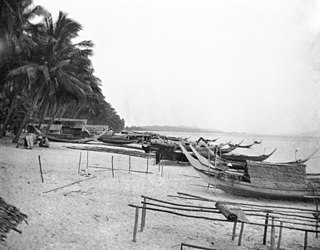 W
WThe Japanese Invasion of Malaya began just after midnight on 8 December 1941 before the attack on Pearl Harbor. It was the first major battle of the Pacific War, and was fought between ground forces of the British Indian Army and the Empire of Japan.
 W
WThe Battle of Kissoué was part of the Allied advance on Damascus in Syria during the Syria-Lebanon campaign in World War II. The battle is noted for the confrontation between Vichy French and the Free French Forces. The Free French met with stiff resistance from the Vichy French.
 W
WThe Battle of Kohima proved the turning point of the Japanese U-Go offensive into India in 1944 during the Second World War of 1939-1945. The battle took place in three stages from 4 April to 22 June 1944 around the town of Kohima, the capital of Nagaland in northeast India. From 3 to 16 April, the Japanese attempted to capture Kohima ridge, a feature which dominated the road by which the besieged British and Indian troops of IV Corps at Imphal were supplied. By mid-April, the small British and Indian force at Kohima was relieved.
 W
WThe Malayan campaign was a military campaign fought by Allied and Axis forces in Malaya, from 8 December 1941 – 31 January 1942 during the Second World War. It was dominated by land battles between British Commonwealth army units, and the Imperial Japanese Army with minor skirmishes at the beginning of the campaign between British Commonwealth and Royal Thai Armed Forces. The Japanese had air and naval supremacy from the opening days of the campaign. For the British, Indian, Australian and Malayan forces defending the colony, the campaign was a total disaster.
 W
WThe Battle of Mersa Matruh was fought from 26 to 29 June 1942, following the defeat of the Eighth Army at the Battle of Gazala and was part of the Western Desert Campaign of the Second World War. The combatant on the Axis side was the Panzer Army Afrika (Panzerarmee Afrika, consisting of German and Italian units. The Allied forces of the Eighth Army comprised X Corps and XIII Corps. The battle developed as the Afrika Korps pursued the Eighth Army as it retreated into Egypt. Rommel intended to engage and destroy the Allied infantry formations in detail, before the British had a chance to regroup. The Axis cut off the line of retreat of X Corps and XIII Corps but was too weak to stop the British from breaking out. The fortress port of Mersa Matruh and 6,000 prisoners were captured, along with a great deal of supplies and equipment but the Eighth Army survived.
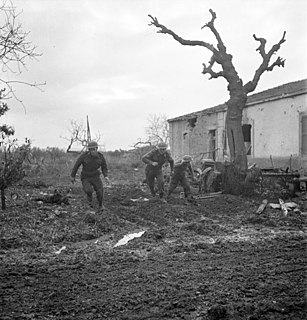 W
WThe Moro River Campaign was an important battle of the Italian Campaign during the Second World War, fought between elements of the British Eighth Army and LXXVI Panzer Corps of the German 10th Army. Lasting from 4 December 1943 to 4 January 1944, the campaign occurred primarily in the vicinity of the Moro River in eastern Italy. The campaign was designed as part of an offensive launched by General Sir Harold Alexander's Allied 15th Army Group, with the intention of breaching the German Army's Winter Line defensive system and advancing to Pescara—and eventually Rome.
 W
WThe North African campaign of the Second World War took place in North Africa from 10 June 1940 to 13 May 1943. It included campaigns fought in the Libyan and Egyptian deserts and in Morocco and Algeria, as well as Tunisia.
 W
WOperation Krohcol, or the Battle for The Ledge, was a British operation in December 1941 to invade southern Thailand following the Japanese invasion of Malaya and of Thailand during World War II. It was authorised by Lieutenant-General Arthur Percival as a "mini Matador" after Operation Matador, a pre-emptive strike into Thailand which had been opposed by the British government and was not carried out. Due to delays in authorisation by Percival and in the forwarding of his order, the need to reorganise the troops for Krohcol instead of Matador, and resistance from Thai policemen the Krohcol column did not reach the Ledge in time.
 W
WThe Battle of San Marino was an engagement on 17–20 September 1944 during the Italian Campaign of the Second World War, in which German Army forces occupied the neutral Republic of San Marino, and were then attacked by Allied forces. It is also sometimes known as the Battle of Monte Pulito.
 W
WThe Battle of Singapore, also known as the Fall of Singapore, was fought in the South-East Asian theatre of World War II when the Empire of Japan invaded the British stronghold of Singapore—nicknamed the "Gibraltar of the East". Singapore was the major British military base in South-East Asia and was the key to British imperial interwar defence planning for South-East Asia and the South-West Pacific. The fighting in Singapore lasted from 8 to 15 February 1942, after the two months during which Japanese forces had advanced down the Malayan Peninsula.
 W
WThe Battle of Sittang Bridge was part of the Burma campaign during the Second World War. Fought between 19 February and 23 February 1942, the battle was a victory for the Empire of Japan, with many losses for the British Indian Army, which was forced to retreat in disarray. Brigadier Sir John George Smyth, V.C.—who commanded the British Indian Army at Sittang Bridge—called it "the Sittang disaster".
 W
WThe Battle of Slim River occurred during the Malayan campaign in January 1942 between the Imperial Japanese Army and the British Indian Army on the west coast of Malaya.
 W
WThe spring 1945 offensive in Italy, codenamed Operation Grapeshot, was the final Allied attack during the Italian Campaign in the final stages of the Second World War. The attack into the Lombardy Plain by the 15th Allied Army Group started on 6 April 1945, ending on 2 May with the formal surrender of German forces in Italy.
 W
WThe Battle of the Tennis Court was part of the wider Battle of Kohima that was fought in North East India from April 4 – June 22, 1944 during the Burma Campaign of the Second World War. The Japanese advance into India was halted at Kohima in April 1944 and Garrison Hill, on a long wooded ridge on a high ridge west of the village, was, according to the Commonwealth War Graves Commission the scene of "perhaps the most bitter fighting of the whole Burma campaign when a small Commonwealth force held out against repeated attacks by a Japanese Division". During the siege of Kohima, heavy fighting, including hand-to-hand combat, occurred in the grounds surrounding the Deputy Commissioner's bungalow, including the tennis court, beginning around April 8 and continuing until May 13 when the assaulting Japanese troops began withdrawing from the area.
 W
WThe Axis capture of Tobruk, also known as the Fall of Tobruk and the Second Battle of Tobruk was part of the Western Desert Campaign in Libya during the Second World War. The battle was fought by Panzer Army Africa an Axis (German–Italian) military force in north Africa, which included the Afrika Korps, led by Generalleutnant Erwin Rommel) and forces from the United Kingdom, India, South Africa and Allied contingents in the British Eighth Army.
 W
WThe British capture of Tobruk was a battle fought between 21 and 22 January 1941, as part of Operation Compass, the first offensive of the Western Desert Force (WDF) in the Western Desert Campaign of the Second World War. After defeating the Italians in the Battle of Bardia, the 6th Australian Division and the 7th Armoured Division pressed on and made contact with the Italian garrison in Tobruk on 6 January.
 W
WThe U Go offensive, or Operation C, was the Japanese offensive launched in March 1944 against forces of the British Empire in the northeast Indian regions of Manipur and the Naga Hills. Aimed at the Brahmaputra valley, through the two towns of Imphal and Kohima, the offensive along with the overlapping Ha Go offensive was one of the last major Japanese offensives during the Second World War. The offensive culminated in the Battles of Imphal and Kohima, where the Japanese and their allies were first held and then pushed back.